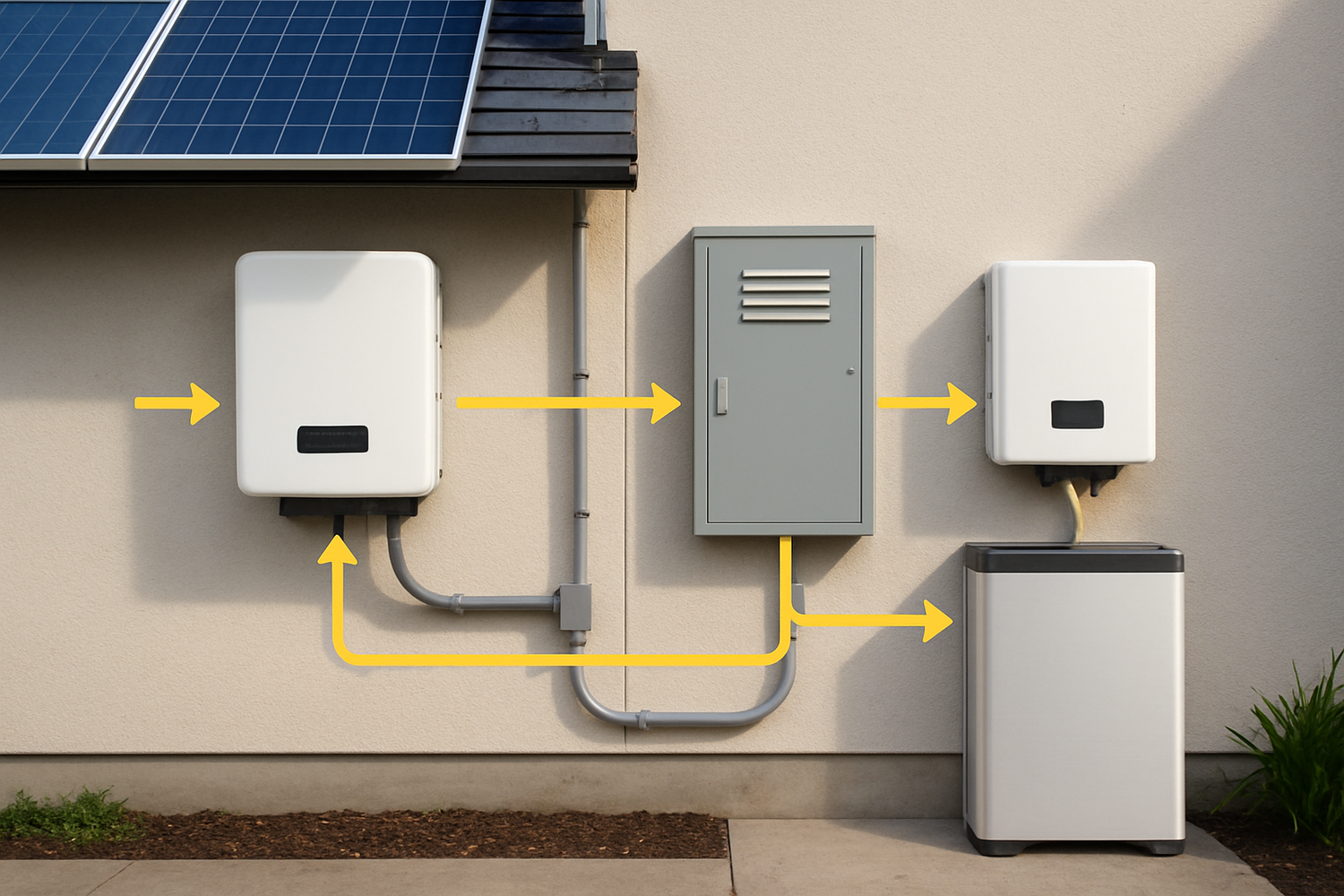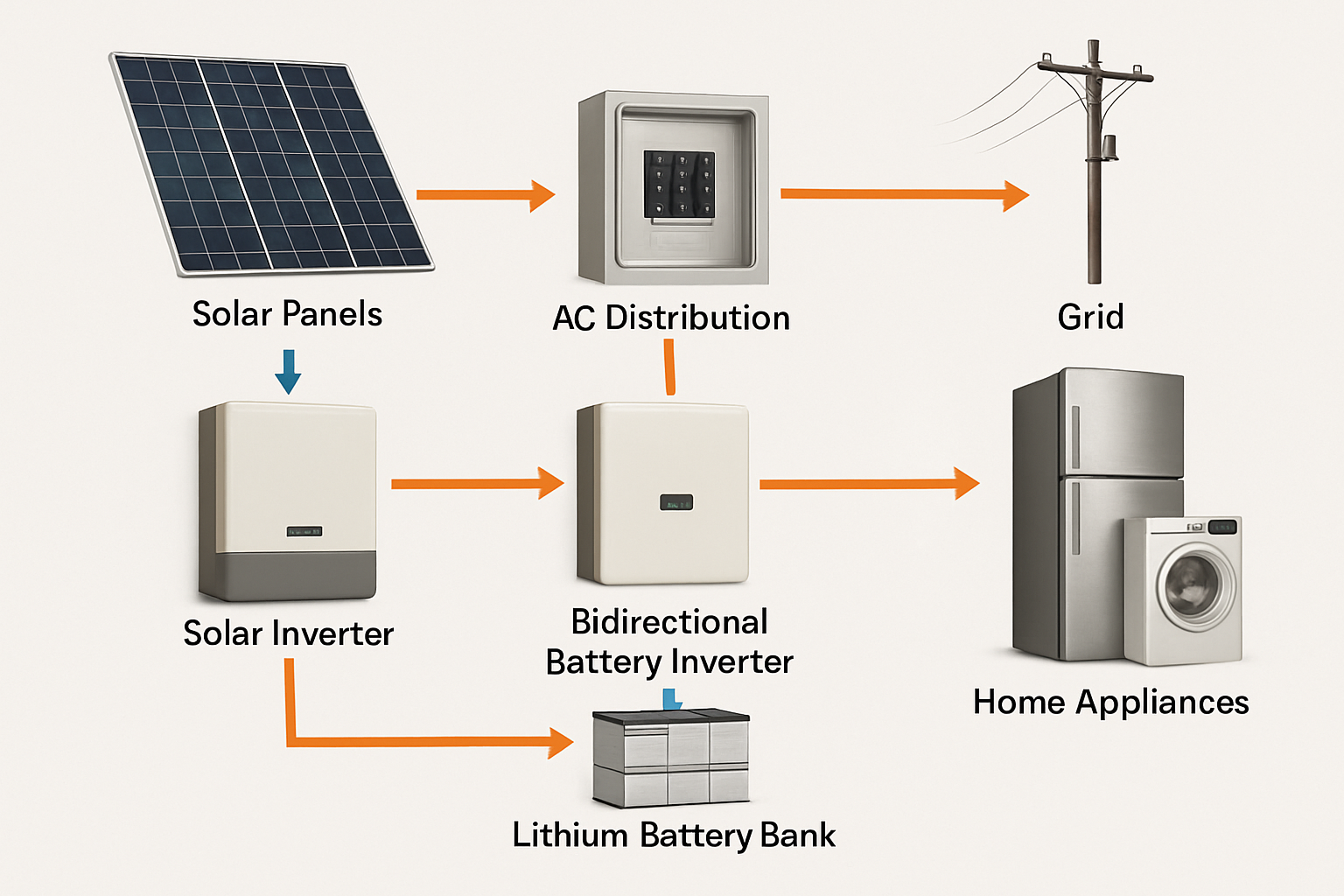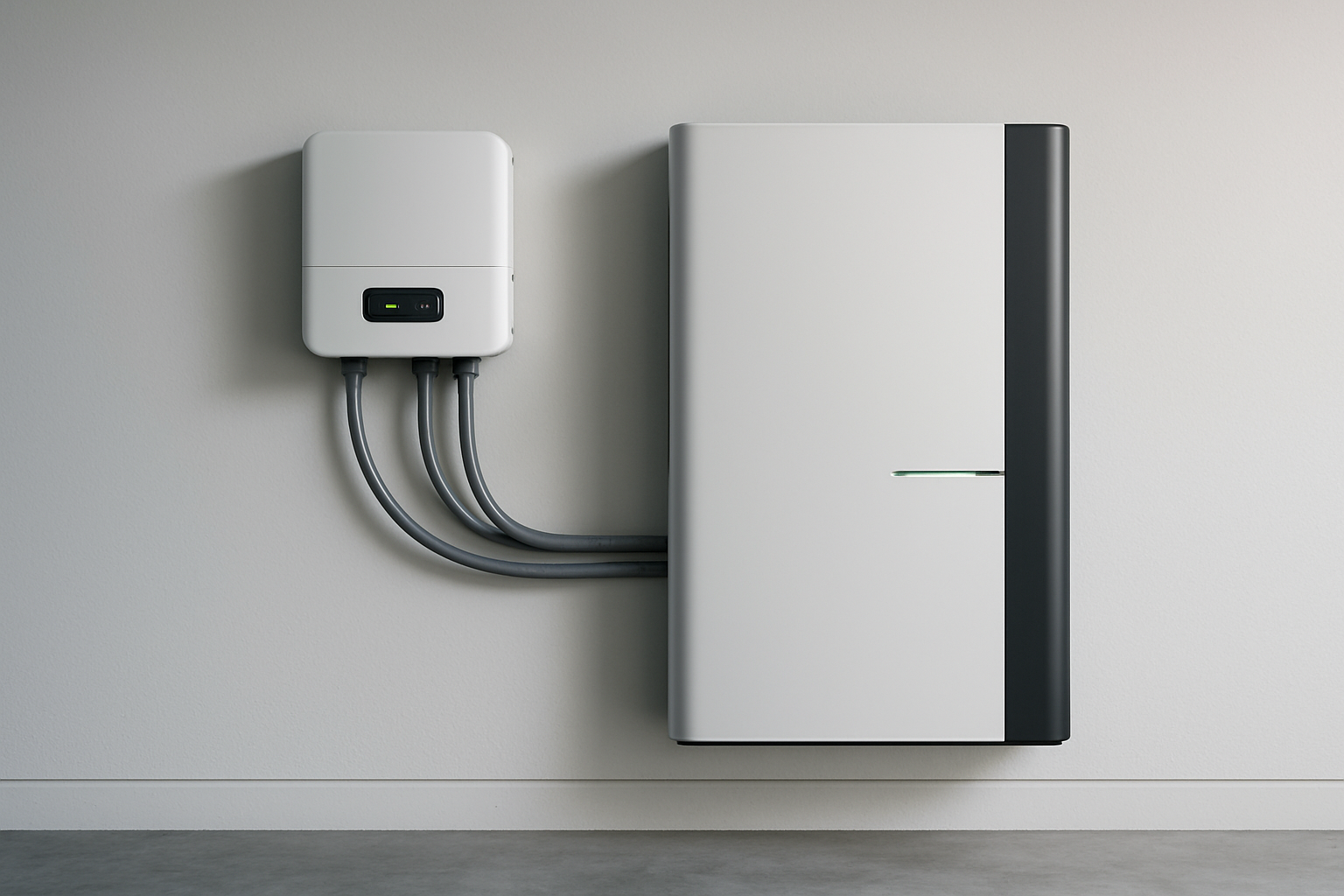As more homes adopt solar power, the conversation naturally turns to energy storage. Storing the excess energy you generate is the key to maximizing your investment and gaining true energy independence. When you decide to add a battery to a solar installation, the way you connect it—or "couple" it—is a critical decision. One of the most flexible and popular methods is AC coupling.
This guide provides a complete overview of an AC coupled battery system. We will cover how it works, its core components, and how it compares to its counterpart, the DC coupled system. This information will help you determine the right approach for your home energy needs.
The Fundamentals of AC Coupling
At its core, an AC coupled system connects a battery to your solar setup on the alternating current (AC) side of your electrical system. This might sound technical, but the concept is straightforward and offers significant advantages, especially for existing solar owners.
How an AC Coupled Battery System Works
Understanding the flow of electricity is the best way to grasp AC coupling. In any solar installation, solar panels produce direct current (DC) electricity. Your home and the electrical grid use alternating current (AC). An inverter is required to make the switch.
Here is the energy journey in an AC coupled setup:
- Solar panels generate DC power.
- A solar inverter converts this DC power into AC power for your home to use immediately.
- Any excess AC power not used by your home is sent to a second inverter, the battery inverter.
- The battery inverter converts this AC power back into DC power to store it in the battery.
When you need to draw power from the battery, the process reverses. The battery releases DC power, which the battery inverter converts back to AC for your home's appliances. Because this setup involves two inverters and a few conversion steps, it is sometimes called a "multi-mode" system.
Key Components of an AC Coupled Setup
An AC coupled battery system is an assembly of several critical components working in harmony:
- Solar Panels: The source of your renewable energy.
- Grid-Tie Solar Inverter: The original inverter that is part of any grid-connected solar panel system. It converts the panels' DC output to AC.
- Battery Bank: The heart of the storage system. Modern systems increasingly rely on high-performance, safe, and reliable Lithium Iron Phosphate (LiFePO4) batteries due to their long lifespan and stability.
- Battery Inverter/Charger: This is the brain of the storage system. It manages the charging and discharging of the battery, converting between AC and DC as needed.
- Main Electrical Panel: The central distribution point for electricity in your home, where all these components connect.
- Monitoring System: Software that allows you to track energy production, consumption, and battery status.
Why Choose AC Coupling? The Core Advantages
The primary reason homeowners and installers choose AC coupling is its remarkable flexibility. This design offers several distinct benefits.
- Perfect for Retrofitting: The standout advantage of an AC coupled system is the ease of adding it to an existing solar panel installation. Because it connects to the AC side, you do not need to alter the existing solar array's wiring or replace the solar inverter. This makes it a simple and cost-effective upgrade. For more on this, see How to Add a Lithium Battery to an Existing Solar System.
- System Independence: The solar panels and the battery system operate independently of each other. If the battery inverter requires maintenance, your solar panels can continue to power your home without interruption. This modularity adds a layer of resilience to your energy system.
- Scalability: If your energy needs grow, you can often expand your battery storage without reconfiguring your solar panel setup. This makes it easier to adapt the system over time.
AC Coupling vs. DC Coupling: A Detailed Comparison
The main alternative to AC coupling is DC coupling, where the battery is connected to the DC side of the system, before the inverter. The choice between them depends heavily on your specific situation. You can get a quick overview in our article, AC Coupled vs DC Coupled: Which Home Battery Storage Is Best?.
Understanding the Core Differences
The fundamental difference lies in the path the electricity takes. In a DC coupled system, DC power from the solar panels can charge the battery directly before being converted to AC for the home. This requires a single, more complex "hybrid" inverter that manages both the panels and the battery.
Here is a table summarizing the key distinctions:
| Feature | AC Coupled System | DC Coupled System |
|---|---|---|
| Best Use Case | Adding storage to an existing solar system (retrofit) | New solar and storage installations |
| Inverters | Two inverters: one solar, one battery | One hybrid inverter |
| Installation Complexity | Simpler to retrofit, less wiring modification | More complex, especially for retrofits |
| Efficiency | Slightly lower round-trip efficiency due to more conversions | Generally higher round-trip efficiency |
| System Redundancy | Higher; solar and battery are independent systems | Lower; a single inverter failure can affect both |
Efficiency Considerations
A common point of discussion is efficiency. Because AC coupling involves converting power from DC to AC (at the solar inverter), back to DC (for the battery), and then back to AC (for use), some energy is lost at each step. This is known as "round-trip efficiency." A DC coupled system, with fewer conversions, is often cited as being more efficient, with some systems reaching 98% efficiency compared to 90-94% for AC coupled systems.
However, this doesn't tell the whole story. If your home uses the solar power as it's being generated, that electricity only goes through one conversion (DC to AC), bypassing the battery entirely. In this common scenario, the efficiency is identical to a DC coupled system. The round-trip efficiency losses only apply to the energy that is stored and later discharged from the battery.
Practical Applications and Installation
An AC coupled battery system is a practical solution for millions of homeowners who already have solar panels. The growing need for reliable backup power and the desire to reduce grid reliance make retrofitting an attractive option.
Retrofitting an Existing Solar System
Adding an AC coupled battery is a streamlined process. While a qualified professional should always perform the installation, the conceptual steps are straightforward:
- System Assessment: An installer evaluates your current solar system's size, your home's energy consumption, and your goals (e.g., backup power for essential appliances).
- Component Selection: Based on the assessment, a compatible battery inverter and a suitably sized battery bank, such as a 12V 100Ah lithium battery, are chosen. You can see a real-world example in this Case Study: A 12V 100Ah Lithium Battery AC Coupled Retrofit.
- Integration: The battery inverter is wired into your home's main electrical panel. This allows it to charge from your solar array and discharge power to your home's circuits.
- Configuration: The system is programmed to operate based on your preferences, such as prioritizing self-consumption of solar power or keeping the battery fully charged for backup.
Common Mistakes to Avoid
Proper planning is essential for a successful AC coupled installation. Rushing the process can lead to inefficiencies and unmet expectations. To ensure you get the most from your investment, it is wise to be aware of potential pitfalls. For a detailed checklist, review these 7 Mistakes to Avoid with Your AC Coupled Solar Battery System.
System Sizing and Performance Metrics
Correctly sizing your battery is crucial. This involves analyzing your daily energy use and determining how many hours of backup you need. Key performance metrics like Depth of Discharge (DoD) and cycle life are also important, as they dictate how much of the battery's capacity you can use and how long it will last. High-quality LiFePO4 batteries offer excellent DoD and cycle life, ensuring a long-term, reliable investment. For a deeper analysis of these metrics, our guide to solar storage performance provides comprehensive data.
The good news for consumers is that battery costs have fallen dramatically. The International Renewable Energy Agency (IRENA) reports that the installed costs of battery energy storage systems could fall by 50% to 60% by 2030, making energy storage more accessible than ever.
The Future of AC Coupled Energy Storage
AC coupled systems are not just about individual homes; they are also poised to play a significant role in the broader energy landscape. Their flexibility and independent control make them ideal for creating more resilient and intelligent power grids.
Integration with Smart Grids
The International Energy Agency (IEA) highlights the growing importance of distributed energy resources, like home batteries, for grid stability. As grids modernize, AC coupled batteries can be easily integrated into programs that help balance supply and demand, reducing strain on the central grid during peak hours. This creates a more robust and efficient energy system for everyone.
Achieving Energy Independence
Ultimately, the goal for many homeowners is greater control over their energy. An AC coupled battery system is a powerful tool to achieve this. By storing your solar energy, you reduce your reliance on utility companies, protect your home from outages, and lower your carbon footprint. It is a key step to Unlock Energy Independence with a Home Battery Storage System.
Integrated solutions, which combine LiFePO4 batteries with a smart battery inverter, offer a seamless path to energy independence. These systems are designed for reliability and scalability, providing a complete solution for modern households.
Making the Right Choice for Your Home
An AC coupled battery system represents a flexible, powerful, and accessible way to add energy storage to a home. Its primary strength lies in its ability to easily retrofit onto any existing grid-tie solar installation, instantly adding backup capabilities and maximizing the use of generated solar power.
While DC coupled systems have their place, particularly for new all-in-one installations, the modularity and simplicity of AC coupling make it the go-to choice for millions of current solar owners. By understanding how this technology works, you can make an informed decision and take a significant step toward controlling your own energy future. If you are still weighing your options, consider reading Is AC Coupling the Right Choice for Your Energy Storage Needs?
Disclaimer: This article is for informational purposes only. It does not constitute financial or legal advice. Please consult with a qualified professional for guidance on your specific energy system installation and to understand any potential financial incentives.





Leave a comment
All comments are moderated before being published.
This site is protected by hCaptcha and the hCaptcha Privacy Policy and Terms of Service apply.